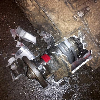topo4u2
Well-Known Member
- Joined
- September 11, 2002
- Messages
- 125
- Reaction score
- 0
- City, State
- Ontario Canada
- Year, Model & Trim Level
- 1995 XLT
This may be a short question to a long answer but if someone has some time could they explain the 4x4 operation in my 95 control trac. I would like to know when the electric motor on the side of the transfer case comes into play(damm thing looks like a wiper motor) and what about that vacuum deal on the front axle.
You can make the explanation as short as possible.
Thanks.
You can make the explanation as short as possible.
Thanks.










